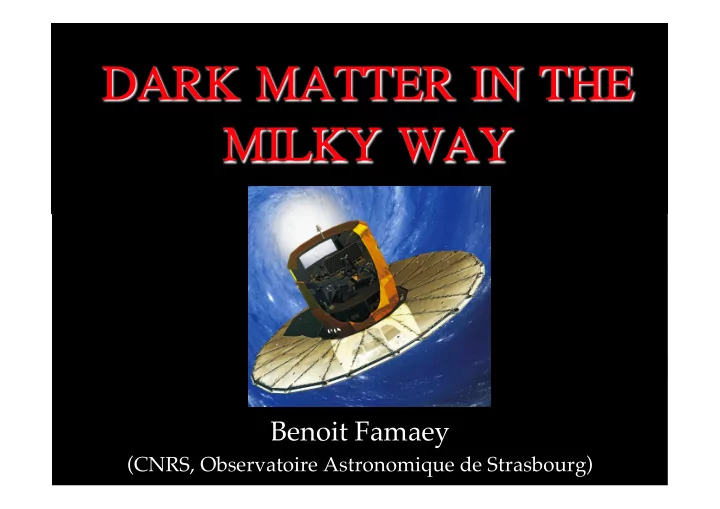

DARK ! !MATTER ! !IN ! !THE ! ! MILKY ! !WAY ! ! � Benoit Famaey � (CNRS, Observatoire Astronomique de Strasbourg) �
CDM challenges on galaxy scales � Big problems � « Small » problems � - Tightness of baryonic Tully-Fisher relation � - Angular momentum problem � - Mass Discrepancy- Surface density - Cusp problem � relation � - Missing sats. problem � - Too big to fail problem & sats phase- space correlation � �
The Milky Way � In principle: ideal local lab to test predictions from CDM, provide precise numbers for direct detection, and constrain any alternative � Problem: we are in it so different challenges than for external galaxies � Very precise data, but not covering the whole Galaxy, even with forthcoming Gaia data �
Extracting the DM profile from � large Galactic surveys � � CAVEATS: � Equilibrium dynamics: pair ( f 0 , Φ 0 ) Collisionless Boltzmann + Poisson Assuming axisymmetric equilibrium model, existing non-axisymmetries can bias the model fit ! � In axisymmetry and equilibrium: f 0 (E, L z ,I 3 ) For instance, Shu DF (locally Schwarzschild): Number of galactic spiral 0 arms? Quasistatic or transient? Pitch angle? Jeans equations (1st order moments of Boltzmann): Amplitude? Pattern speed? Parameters of bar? Triaxial dark halo? … �
Milky Way rotation curve � Needs: - Distance of the Sun to the Galactic Center R 0 - Circular Velocity at the Sun’s radius V 0 - Peculiar velocity of the Sun itself V sun Reid & Brunthaler (2004) Sgr A*: if R 0 =8kpc, V 0 +V sun = 241 km/s McMillan & Binney (2010): use velocities of star forming regions with known parallaxes, minimize non-axisymmetric motions Enormous uncertainties: apart from V 0 /R 0 = 30.7 +- 0.9 km/s/kpc Best fit: R 0 = 7.8 kpc, V 0 = 247 km/s, V sun = 11 km/s Literature values: R 0 from 6.5 kpc to 9.5 kpc V 0 from 180 km/s to 300 km/s V sun from 5 km/s to 25 km/s
V 0 = 247 km/s ⇒ offset from the luminous and baryonic Tully-Fisher relations? V 0 = 210-220 km/s => OK for Tully-Fisher BEWARE: LARGE UNCERTAINTIES + NONAXISYMMETRIC MOTIONS MIGHT BIAS V 0 !!!! Hammer et al. 2007
Milky Way rotation curve � At R<R 0 : Vc(R 0 sin l)=V rmax + V c (R 0 ) sin l BUT at R>R 0 : one measures Ω (R)- Ω (R 0 ) and one needs the distance of tracers (masers with interferometric parallax) Bump? Binney & Dehnen (1997): data compatible with a gently declining RC if overdensity of TRACERS Beware: non-axisymmetries! (spiral arms) Central parts: not much work taking into account effects of the bar DM halo fit(s)
Milky Way rotation curve � Central parts: Reproduce non-axisymmetric features in gas motions with non-axisymmetric central bar (Bissantz et al. 2003) A priori not possible with central cusp! Model with V 0 =220 km/s ρ DM = ρ 0 (1+r 2 /3a 2 ) / (1+r 2 /a 2 ) 2 with ρ 0 = 0.027 M sun /pc 3 and a=10.7 kpc
Vertical equilibrium � Fix distribution function and fit Galactic potential � � Bienaymé et al. (2014): 4600 red clump giants in 500 pc cylinder �
Vertical equilibrium � Fix distribution function and fit Galactic potential � � Bienaymé et al. (2014): 4600 red clump giants in 500 pc cylinder � Confirmed by Piffl et al. (2014) ρ localDM =0.014 M sun /pc 3 = 0.54 GeV/cm 3 Quite high compared to what is usually assumed!
« Breathing » mode � � � RAVE survey: nonzero radial and vertical mean motions � (Siebert et al. 2011, 2012; Williams et al. 2013) �
Linearized Jeans equations for cold stellar fluid in 3D � Assume only one main non-axisymmetric perturber, long-lived enough (~1 Gyr) so that the stationary response is meaningful. Faure et al. (2014) Tightly-wound spiral: � Linearized Jeans equations (zero dispersion): Solution is sum of terms of the form: 1
Faure, Siebert & Famaey (2014 MNRAS 440 2564)
Reduction factor: simulations � Test particles response (Faure et al. 2014), Background potential from BT08, � Spiral potential cf. Siebert et al. (2012), ICs from Shu DF for 40 M particles � => stable response in rot. frame � N-body (Debattista 2014) 3M particles, large pitch angle ~ 40°:
=> More direct modelling might be needed concerning the density above and below the plane: Compute high-resolution simulations with bars and spirals (+satellite bombardment?),compare directly to vertical velocity field structure
Conclusions � Galactic scales problems might need to rethink LCDM � Core vs Cusp: fitting non-axisymmetric motions seem to require core in MW: � ρ DM = ρ 0 (1+r 2 /3a 2 ) / (1+r 2 /a 2 ) 2 with ρ 0 = 0.027 M sun /pc 3 and a=10.7 kpc Local vertical equilibrium from RAVE stars � => ρ localDM = 0.54 GeV/cm 3 � � Assumption of local vertical equilibrium in axisymmetric system not accurate � More direct modelling might be needed + more reliable distances! => Gaia astrometry! �
Recommend
More recommend